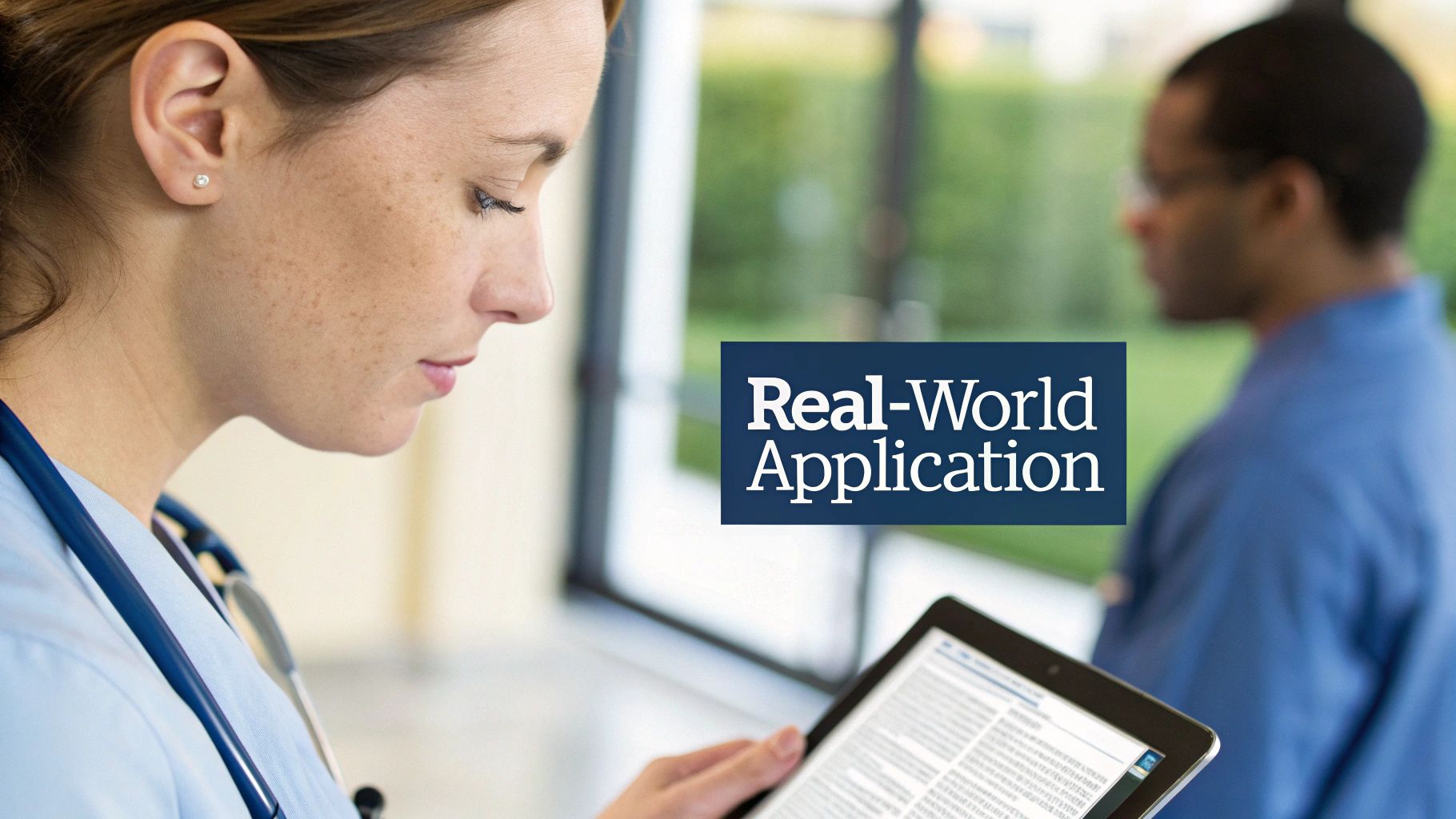Medical Transcription Training: Your Complete Guide to Mastering Healthcare Documentation
Breaking Into Medical Transcription: What You Really Need to Know

Medical transcription offers an engaging career path combining healthcare knowledge and technical abilities. Before investing time and resources into training, it's important to understand what the role actually entails. Let's explore the realities of this profession through insights from working professionals in the field.
Beyond Just Typing: The Evolving Role of the Medical Transcriptionist
Gone are the days when medical transcription meant simply typing up dictated notes. Modern transcriptionists need extensive knowledge of medical terminology, anatomy, and human physiology. The work involves carefully interpreting complex medical reports filled with specialized terms and abbreviations. This shift has made comprehensive training essential for anyone entering the field. Rather than just typing skills, successful transcriptionists must develop deep healthcare documentation expertise.
Essential Skills and Daily Realities
The daily work of a medical transcriptionist requires strong critical thinking and precise attention to detail. Transcriptionists frequently work with different dictation styles, accents, and audio quality levels, making it crucial to accurately capture the intended meaning. They must also be comfortable using electronic health record (EHR) systems and medical software. A typical workday includes transcribing various medical documents like patient histories, physical exams, surgical reports, and discharge summaries - all requiring both speed and complete accuracy.
Addressing Common Misconceptions
Some believe that speech recognition technology will eventually replace medical transcriptionists. While technology plays a growing role, human expertise remains vital for ensuring accurate and contextual medical documentation. Skilled transcriptionists, especially those with specialized certifications, continue to be in demand. Another myth is that the work lacks flexibility, when in fact many transcriptionists work remotely with adaptable schedules. According to the U.S. Bureau of Labor Statistics, around 9,600 medical transcriptionist positions open annually, mainly to replace existing workers.
Building a Sustainable Career Through Medical Transcription Training
Selecting the right training program sets the foundation for career success. While the Bureau of Labor Statistics reports that medical transcriptionists earned a median salary of $37,060 in May 2023, income varies based on experience, location, and specialty areas. When evaluating programs, carefully consider the curriculum content, hands-on practice opportunities, and paths to certification. Quality training equips you with the comprehensive skills needed to handle complex healthcare documentation and build a rewarding long-term career in this essential field.
Mastering the Core Skills That Actually Matter

Success in medical transcription requires more than just fast typing skills. To excel in this field, aspiring transcriptionists need to develop specific core competencies that enable them to accurately convert spoken medical information into clear written documentation. Understanding and mastering these essential skills creates the foundation for a successful career path.
Decoding Medical Terminology: The Foundation of Accuracy
Medical terminology knowledge forms the bedrock of accurate transcription work. Consider how critical it is to understand the difference between similar-sounding terms like "hypoglycemia" and "hyperglycemia" - mixing these up could have serious implications for patient care. A solid grasp of anatomy and physiology helps transcriptionists put medical terms in proper context and catch potential errors. Quality medical transcription training programs emphasize building this fundamental medical vocabulary and knowledge base.
Developing Speed and Accuracy: A Balancing Act
While strong medical terminology skills are essential, transcriptionists also need to maintain both speed and precision in their work. The key is finding the right balance - typing quickly while maintaining high accuracy rates. This comes through dedicated practice with real-world medical dictation samples. The best training programs provide extensive hands-on exercises that help students steadily build both their typing speed and accuracy over time.
Navigating Complex Healthcare Documents: Beyond the Basics
Medical transcriptionists work with many different types of clinical documentation, from patient histories to surgical notes. Each type has its own format and critical elements that must be captured accurately. For example, when transcribing lab results, understanding normal ranges and clinically significant values helps ensure important details aren't missed. Effective training teaches students how to handle the full range of medical document types they'll encounter on the job.
Embracing Technology: Tools of the Trade
Modern medical transcription relies heavily on specialized tools. Students need practical experience with transcription software, electronic health record (EHR) systems, and speech recognition technology. However, it's also important to understand the limitations of AI tools and maintain high standards for accuracy and patient privacy. By combining strong technical skills with medical knowledge and attention to detail, transcriptionists can provide valuable documentation services that support quality patient care.
Hands-On Practice: Building Real-World Expertise
Learning medical transcription requires going beyond theory into real-world practice. By working with actual medical dictations and scenarios, you can develop the practical skills needed to succeed in this field. Let's explore the key ways successful transcriptionists build their expertise through hands-on experience.
Simulating the Real World: Effective Training Approaches
Quality medical transcription programs create realistic training environments that mirror actual work settings. Students practice with recordings of physician dictations across different medical specialties - from cardiology reports to oncology notes. This exposure helps them gain experience with various document types like patient histories, discharge summaries, and operative reports. Many programs also incorporate electronic health record (EHR) software, allowing students to work with the same tools they'll use in their careers. This practical training builds the speed and accuracy essential for professional work.
Refining Your Skills: Practice Methods That Yield Results
Like any skill, medical transcription improves with focused practice. Rather than repeatedly typing the same documents, successful students work with diverse materials featuring different dictation styles, audio qualities, and medical specialties. For example, after mastering a cardiology report, they might tackle a neurology dictation to expand their medical vocabulary and understanding. Regular self-assessment against quality standards helps identify areas needing improvement. This targeted approach leads to steady skill development.
Beyond Technical Skills: Cultivating Critical Thinking
Good transcriptionists combine typing skills with sharp analytical abilities. They actively process information rather than simply typing what they hear. When encountering unclear or contradictory details in a dictation, they know to seek clarification instead of reproducing potential errors. Training programs develop these judgment skills through case studies, peer review sessions, and discussions about healthcare documentation ethics. This analytical foundation helps transcriptionists produce accurate, reliable medical records.
Measuring Your Progress: Benchmarks and Best Practices
Tracking your performance against industry standards is essential for growth. Key metrics include typing speed, accuracy rates, and proper use of medical terminology. Most training programs include regular assessments and practical exams to measure these abilities. By monitoring your progress, you can adjust your learning approach and prepare for real workplace demands. This focus on practical skill development equips you for success in professional medical transcription.
Navigating Certification and Professional Development

Getting trained as a medical transcriptionist is just the beginning of your career journey. To build a successful long-term career, you'll need to focus on certifications and ongoing learning. These credentials not only showcase your expertise but also directly affect your job opportunities and income potential.
The Value of Certification in Medical Transcription
Though not always required, professional certification gives you a strong advantage in the field. The Association for Healthcare Documentation Integrity (AHDI) offers the Registered Healthcare Documentation Specialist (RHDS) exam, which is widely respected in the industry. This certification proves your mastery of medical terminology, transcription methods, and professional ethics. With the U.S. Bureau of Labor Statistics showing around 9,600 annual job openings for medical transcriptionists, having these credentials helps you stand out to employers.
Continuing Education: Staying Ahead of the Curve
The medical field constantly introduces new technologies, terms, and regulations. To stay competitive, you need to keep learning and developing your skills. For example, taking additional training on new electronic health record systems or updated medical coding guidelines ensures you remain valuable to employers. This commitment to ongoing education can lead to specialized roles with better pay. It also shows that you take pride in producing accurate, current medical documentation.
Leveraging Professional Associations for Growth
Groups like the AHDI offer excellent resources for career growth. They provide educational courses, host conferences, and maintain online communities where you can connect with other professionals, exchange tips, and follow industry changes. Being part of these organizations also gives you access to job listings and mentoring programs. This network becomes particularly important in medical transcription, where precision and best practices directly affect patient care. Making the most of these professional development opportunities can significantly boost your career progress and earning potential in medical transcription.
Understanding Your Career Potential and Growth Path

Medical transcription training provides multiple paths for career development within healthcare documentation. Rather than limiting you to a single role, this field offers opportunities to explore specialized areas and advance to higher positions as you gain experience. Let's explore the many ways you can grow your career after completing medical transcription training.
Exploring Salary Ranges and Earning Potential
According to the U.S. Bureau of Labor Statistics, medical transcriptionists earned a median annual salary of $37,060 as of May 2023. However, actual earnings can vary considerably based on your specific situation. Entry-level positions typically start at lower salaries, while experienced transcriptionists command higher pay. Geographic location plays a major role too - areas with higher living costs or greater demand for medical transcription services often offer better compensation. For example, transcriptionists who specialize in fields like radiology or cardiology can earn above-average salaries due to their expert knowledge.
Specialization: Focusing Your Expertise
One effective way to increase both your income and job satisfaction is by specializing in a specific medical field. By developing deep expertise in one area, you become particularly valuable to healthcare providers in that specialty. For instance, oncology transcriptionists master cancer-related terminology and documentation requirements, while those in cardiology become experts in heart-related medical language and reports. This focused knowledge helps you work more efficiently and accurately, making you an essential asset to medical practices in your chosen specialty.
Advancement Opportunities: Climbing the Career Ladder
Medical transcription offers clear paths for career growth beyond entry-level positions. As you gain experience and continue learning, you can move into supervisory or management roles where you'll oversee other transcriptionists, maintain quality standards, and manage department workflows. Some professionals choose to share their knowledge by becoming trainers or educators for new transcriptionists. Your medical transcription background can also serve as a foundation for moving into other healthcare information management positions.
Building Your Network: The Importance of Professional Relationships
Success in medical transcription depends heavily on building strong professional connections. Getting involved with organizations like the Association for Healthcare Documentation Integrity (AHDI) gives you chances to meet other professionals in your field. By connecting with fellow transcriptionists, healthcare workers, and industry leaders, you can find mentors, learn about job openings, and stay current with industry changes. These relationships often prove invaluable for sharing knowledge about medical terminology updates and documentation practices, directly supporting your long-term career growth.
Landing Your First Role and Building Professional Success
Successfully completing medical transcription training sets you up for a meaningful healthcare career. The next step is turning your new skills into a real-world role. This means showing potential employers that you're a qualified and reliable medical transcriptionist who can deliver accurate work.
Crafting a Compelling Resume and Cover Letter
Your application materials make your first impression on employers. Focus on highlighting your medical transcription training, skills in medical terminology and healthcare knowledge. Include specific examples and metrics whenever possible - for instance, noting "98% accuracy rate transcribing patient records using medical transcription software" is more impactful than just listing "proficient in transcription." Your resume and cover letter should clearly communicate both your technical capabilities and your commitment to quality.
Acing the Interview: Showcasing Your Expertise
During interviews, you'll have the chance to demonstrate your medical transcription knowledge directly. Come prepared to discuss your training background, share examples of handling complex medical terminology, and explain your approach to ensuring accuracy. Focus on showing both your technical abilities and essential soft skills like attention to detail and reliability. Remember that employers look for candidates who can work independently while maintaining consistently high standards.
Building Your Professional Portfolio: Demonstrating Your Value
A strong portfolio gives employers concrete proof of your transcription abilities. Include your best work samples across different medical document types - from patient histories to surgical notes. If you have expertise in specific areas like cardiology, feature relevant examples. Real work samples help employers evaluate your skills firsthand and see the quality you'll bring to their organization.
Establishing Yourself in the Field: Networking and Ongoing Development
After landing your first role, keep expanding your skills and professional network. Join the Association for Healthcare Documentation Integrity (AHDI) to access industry updates, training, and connections with experienced transcriptionists. Regular networking and continuing education show your dedication to growth and can lead to advancement opportunities. Getting additional certifications in specialized areas is another great way to increase your value and earning potential.
Medical transcription training provides a strong foundation, but success comes from effectively marketing your skills and continuing to develop professionally. Focus on crafting compelling application materials, acing interviews, building a strong portfolio, and growing your expertise over time. For more ways to boost your productivity, consider exploring tools like Whisperit, a secure platform for dictation, transcription and editing that can help streamline your workflow.